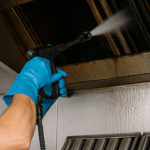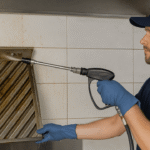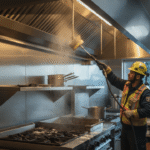Are you frustrated with those dirty kitchen grease traps & have no clue what to do next? Or are you looking for some professional guidance to clean them up? Well, we are here to your rescue!
To run a commercial kitchen is not easy, as it comes with a lot of responsibilities. But in order to be successful at what you do, you need to keep running your kitchen smoothly and safely. And one of the most important parts of maintaining a clean kitchen is — Cleaning the Grease Traps! At Discount Hood Cleaners, we do understand that sometimes this essential task can be overlooked.
That’s why we are here to guide you through our step-by-step cleaning process for the grease trap! You will also understand why it’s not just beneficial, but a necessity that can’t be ignored. From protecting your plumbing to creating a healthy kitchen environment, this article will explain everything so that your kitchen & restaurant remain the best place to dine in!
What Is Meant By Grease Traps?
Grease traps or grease interceptors are plumbing devices that help to trap the oils, fats and FOG from the kitchen wastewater before it makes its way through the sewer system. They are helpful in preventing these elements from blocking pipes, resulting in sewer backups and beyond. Grease traps ensure efficient flow of water and eliminate undesired odors.
Why Is It Essential To Clean The Grease Traps Regularly?
When it comes to grease traps, it’s important to clean them regularly because it is not just about cleanliness, but it’s also about making your kitchen run in an efficient manner. Cleaning the grease trap is essential in order to prevent the accumulation of FOG and blockages in the pipe systems, leading to costly repairs.
Additionally, dirty grease traps also produce foul odors and attract germs, which can have an adverse effect on your restaurant. Therefore, timely cleaning even helps to extend the lifespan of the plumbing system, save you money over time and avoid any compliance problems with the local laws.
How Often Should The Grease Traps Be Cleaned?
How often you should clean your grease trap actually depends on the trap size and how much oils, fats & FOG (grease) is produced by your restaurant kitchen. As a general rule, it is always recommended to clean the grease traps every quarter.
But if your kitchen tends to generate a lot of grease, you may need to clean it frequently. To be sure, it’s best to opt for some professional guidance who can suggest the appropriate cleaning schedule for your kitchen.
Here Are The Tools Needed To Clean The Grease Traps!
Before you begin with the cleaning process, make sure to collect all the protective gear and ventilate the space properly by opening the windows and switching on fans. This will help you reduce the foul smell and make the entire process comfortable.
Here’s all you’ll need:
- Safety Goggles
- Rubber Gloves
- A Buckey
- A Plastic Scrapper
- Degreaser
- Screwdriver
- Grease Trap Pump Or Wet/Dry Vacuum
- Hose With A High-Pressure Nozzle
- Stiff-Bristled Brush
7 Easy Steps To Follow To Clean The Grease Traps
1) Wear Your Protective Gears — Firstly, be prepared and wear the safety goggles as well as rubber gloves to safeguard yourself from any splashes.
2) Turn The Power Off — Firstly, make sure to turn off the power to the grease traps for your safety. This will also help in stopping the trap from filling up the water during the process and make the task more easier and less messy.
3) Pull Out The Lid — Remove the lid utilizing a screwdriver from the grease trap. Make sure to do this carefully to avoid any splashing of trapped grease or water. Set the lid aside.
4) Take Out The Grease — Using a plastic scrapper, take out the grease from the grease traps and put it into the bucket.
5) Scrape & Scrub The Trap — Utilize the plastic scrapper again to scrape the remaining grease residing in the trap walls or the bottom. Next, apply the degreaser and leave it for a few minutes to loosen up any remaining FOG. Lastly, use a stiff-bristled brush to scrub the trap nicely.
6) Reassemble The Grease Trap — After the trap is adequately cleaned, it’s time to reassemble the grease trap. Put the lid back and tighten the screws.
7) Dispose The Waste Properly — Dispose off the waste collected during the cleaning process and ensure not to pour the grease down in any other sink or drain. It’s important to throw out the waste in accordance with the local waste rules & regulations. This helps to avoid any harm to the environment and fulfill legal policies.
Set Up A Regular Cleaning Schedule With Us Today!
Maintaining a commercial kitchen yourself is a stressful task, but an important one, and being consistent can only save your business! Well maintained kitchen and grease traps can help reduce unexpected problems and will make sure that your kitchen stays functional all day long.
However, you can make it an easy job by establishing a regular cleaning schedule on the basis of the usage level of your kitchen with Discount Hood Cleaners! Yes, DIY is great, but there are times when opting for professional help becomes essential. If you come up against persistent clogs, unpleasant odors or rising water levels, it’s time to call the professionals!
Our team of experts is equipped with the right tools and has the expertise, along with experience, to manage challenging situations. By trusting us, you don’t have to worry much as your kitchen will be in the right hands!
Get In Touch With Us Right Now!
In Summary
One of the most crucial parts of maintaining a clean and safe commercial kitchen is to clean the grease traps regularly. By following the steps mentioned above, you can make sure that the grease traps stay clean and operational, preventing any repair expenses as well as establishing a worthwhile reputation for your restaurant!
At Discount Hood Cleaners, we comprehend the necessity of maintaining a safe as well as clean kitchen and that’s why we are here to support you to achieve success in your business!



